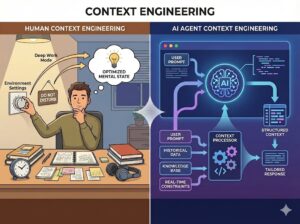Summary Insight:
The hiring funnel is dead. In an AI-saturated world, polish is cheap — proof is priceless. The winners won’t widen their funnels; they’ll invert them to test truth inside real work.
Key Takeaways:
- AI destroyed résumé signals — competence must be observed, not claimed.
- Shift from screening for polish to testing for performance in flow.
- Design hiring systems that reveal capability under real constraints.
This article was originally published on Lex Sisney’s Enterprise AI Strategies Substack.
AI hasn’t just changed how people work.
It’s changed what talent looks like.
Every résumé, headshot, and portfolio now looks immaculate.
Every candidate sounds thoughtful, confident, and “mission‑aligned.”
And every recruiter is drowning in a sea of digital perfection.
That noise isn’t just a side effect — it’s the message.
AI isn’t only fabricating résumés; it’s performing the very work those résumés once proved.
The hiring funnel collapsed because the signal it measured moved inside the system itself.
The Funnel Was Built for a Different Era
For decades, hiring followed an industrial logic:
- Attract as many applicants as possible.
- Filter via résumés, interviews, and tests.
- End with a shortlist of “qualified” people.
It worked because surface signals once correlated with reality:
- Clean résumé? → Likely competent.
- Good grammar? → Probably thoughtful.
- Polished cover letter? → Cares about the role.
That world is gone.
Generative tools have flattened the signal‑to‑noise ratio.
Anyone can produce a flawless résumé in seconds.
- The cost of faking competence has dropped to zero.
- The cost of verifying authenticity has exploded.
The old funnel no longer filters — it floods.
But the real reason it’s failing is deeper:
The funnel was built for a world where humans did the work.
That script has flipped.
Work Has Become Agentic
Beneath the hiring noise, something more profound is happening:
work itself is decomposing into agentic tasks.
As AI takes on repeatable, spec‑driven work, humans move up the stack toward what can’t be automated:
- Setting intent and constraints
- Understanding context
- Decomposing problems into prompts and workflows
- Coordinating across tools, teammates, and feedback loops
- Exercising judgment and taste when trade‑offs are ambiguous
The value frontier has shifted from doing to orchestrating.
You’re no longer hiring people to perform tasks.
You’re hiring people to design and direct systems that perform them — including AI agents, teammates, and feedback loops in sync.
The old funnel mistakes artifacts for evidence when the real signal now lives in how people orchestrate systems.
You don’t need wider funnels. You need mechanisms that validate capability inside your environment.
Make Work the Filter
A decade ago, in How to Think About Hiring, I described the “Show Me Test”: letting candidates prove skill through real work.
In 2013, that came after a qualified candidate was identified.
Now, it belongs near the top.
Front‑loading reality does two things:
- Reduces the weight of paper credentials.
- Shows how candidates actually perform in flow.
What does a “Show Me Test” look like now — when AI is part of the team?
Marketing: “Here’s our latest deck. Record a Loom walking us through what you’d change and why.”
Sales: “Our AI will play the customer. Let’s see how you adapt in real time.”
Engineering: “Here’s the spec. Use your preferred coding agent to ship a version in under five minutes. Narrate your thinking.”
Admin/Legal: “Here’s a scenario we’ve faced. Outline the risks and how you’d mitigate them without slowing the business.”
Build your filters around observed behavior under real constraints.
Use AI to scale the process:
- Favor live or recorded interaction over text — show thinking in motion.
- Program AI for real‑time engagement, not polished replies.
- Craft prompts that reveal depth and judgment, not template fluency.
- Don’t overload — short, intense, revealing beats long and tedious.
- Apply the same method to human and digital agents alike.
Verify Later, Not Sooner
Credential checks still matter — but stop wasting time verifying every glossy résumé.
There’s an arms race between creators of fakery and the AI built to detect it.
You’ll never win it upstream.
Verify only after you’ve seen capability in action.
That simple inversion makes every interview far more valuable.
During interviews, look for:
Narrative continuity: Does their story hold across time and context?
Contextual recall: Can they describe real constraints and trade‑offs?
Work style: How do they think, communicate, and handle ambiguity?
Values: What inner drivers or principles show up in their choices?
The recruiter of the future is less résumé screener, more investigator of fit — assessing performance and cultural alignment among people who’ve already proven they can execute.
Date Before You Marry
The antidote to AI polish is observed behavior over time.
Short, paid trials, consulting starts, and part‑time collaborations reveal truth faster than ten interviews.
AI can fake artifacts.
It can’t fake impact inside your system.
New Roles for the Agentic Age
As work becomes system‑orchestrated, roles shift toward:
Strategic Coordinators: Translate intent into agent workflows.
Domain Leads: Pair deep craft skill with AI leverage.
System Integrators: Connect tools, data flows, and QA loops.
Human Interfaces: High‑context communicators bridging nuance and trust.
These aren’t ivory‑tower roles. They’re the new frontline.
Building Your “Known Universe of Trust”
Recruiting shifts from casting a net to curating a network where authenticity is structurally proven.
- Referrals 2.0: Loop in alumni, ex‑contractors, and proven partners.
- Community sourcing: Go where actual builders gather — niche Slack groups, GitHub repos, trade associations.
- Alumni programs: People who’ve worked with you before are your highest‑signal source of truth.
AI handles the transactions.
Trust comes from shared experience.
The New Hiring Advantage
The funnel hasn’t just collapsed — it’s inverted.
Your edge now comes from verifying truth sooner and closer to real work.
Five moves to operationalize:
- Tighten the top: Source only from verified or referred networks.
- Front‑load reality: Start with a “Show Me” step, not a résumé screen.
- Verify downstream: Validate credentials only after performance.
- Trial before hire: Run short, paid engagements.
- Curate your ecosystem: Build a living network of trusted humans and agents.
The future of hiring isn’t screening for polish.
It’s designing systems that reveal truth through execution.
In an age that can fake the signal, credibility lives in observed performance.




